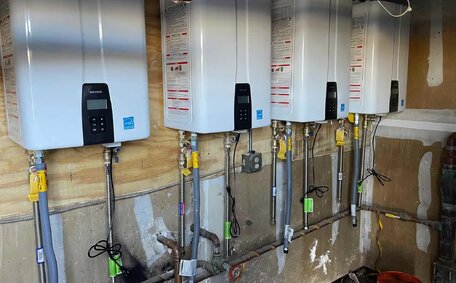Understanding Why Pipes Freeze and Burst
Pipes can burst when temperatures plummet, due to water expanding inside them as it freezes. When water in pipes freezes and expands, it exerts pressure that can cause ruptures. Even a small crack from minor freezing in a pipe can escalate quickly into a significant leak, causing havoc in your home potentially leading to extensive damage.
Burst pipes can extensively damage structures and interiors in your home. Flooding from burst pipes can warp floors, promote mould growth, and necessitate major repairs, impacting the sanctity of your home. It’s vital to grasp the risks and employ preventive strategies, such as insulation, to avert pipe freezing.
Pipes in unheated basements, garages, crawl spaces, and within exterior walls are at greater risk of freezing. Pipes in attics, within uninsulated interior walls, or behind cabinet corners are especially susceptible to freezing during severe cold spells.
Identifying Areas in Your Home Vulnerable to Freezing
In Colyton, Sydney, regions at risk of the dilemma of how prevent frozen pipes include:
- Unheated spaces like garages, attics and crawl spaces
- Rooms lacking insulation like basements and bonus rooms
- Exterior walls and areas behind cabinets on those walls
- Pipes running through uninsulated interior walls
- Areas around windows and doors
- Outdoor pipes and hose bibs
Check for frozen pipes in these vulnerable spots and turn off the water to minimise damage during cold snaps. Protect your plumbing by ensuring your home is well-insulated, using space heaters as necessary, and checking the seals on doors and windows. It’s a good idea to prepare an emergency contingency plan in case any of your plumbing encounters issues such as freezing or bursting.
Winterizing Your Plumbing System
Effectively winterizing kitchens, bathrooms, and other areas is key to preventing frozen pipes in Colyton, Sydney. Follow these essential tips to keep your home safe and prevent water damage:
- Insulate water pipes in unheated areas with sleeves, heat tape, or foam to prevent freezing. This insulation guards against water freezing in the pipes due to cold air.
- Before winter, drain external spigots by shutting off their water supply lines. Use hose bib covers to prevent water from freezing inside them.
- Seal leaks around pipes, doors, windows, and vents to enhance warm air circulation and lower freezing risks. This method effectively keeps warm air in and cold air out, curbing the chances of freezing.
- During the very cold winter months, set your smart thermostat to at least 55° F (13° C) even when you’re not at home. Keep indoor temperatures consistent with your heating system to mitigate the risk of freezing and protect your boiler.
- Before winter, locate and note your main water valve to ensure you can swiftly shut it off if needed. Ensure it’s clearly labelled for quick access to shut off the water during any frozen pipe emergencies.
- Disconnect garden hoses to mitigate the confusion on what do when you have frozen pipes. Retained water inside can cause pipes to undergo freeze-induced expansion, as water expands, resulting in cracked fittings.
- Contemplate fitting your exposed pipes with heat tracing wire or cables that activate at about 4° C, which can help prevent freezing.
Understand how to keep your plumbing safe by taking these preventive measures seriously. Homeowners insurance may deny claims if frozen pipes can be attributed to inadequate winterization of your plumbing.
Detecting Early Signs of Frozen Pipes
Detecting frozen pipes early is essential to prevent them from bursting and causing significant damage. Watch for these common early signs:
- If only a trickle comes out of your faucets, there might be frozen water in the pipes, it’s likely frozen water blockages inside pipes restricting water flow first before fully stopping it.
- Pipes feel much colder than room temperature when touched. Use caution not to disturb pipes before learning how to thaw them safely in sections.
- Unusual gurgling, whistling, or banging noises when turning on fixtures may indicate ice movement inside the pipes.
- Nearby walls, floors or ceilings show water staining. Small leaks may emerge as ice expands pipes.
- Frost, ice or condensation form on pipes. Check around pipe sections prone to freezing first.
If you notice these red flags, Take immediate action if you detect signs of a frozen pipe to prevent a burst. Shut off water immediately and call plumber to assess for freeze damage before a burst water pipe occurs. The sooner you address issues, the less damage a pipe burst can do to your home.
Thawing Frozen Pipes Safely
It’s essential to methodically thaw pipes and tanks to avert the risk of bursting. Avoid using direct, intense heat that could fracture ice inside and potentially worsen the situation. Follow these safe thawing methods instead:
- Maintain a steady water flow in affected pipes during winter to prevent freezing. This step relieves the pressure that can cause pipes to crack when ice starts to melt.
- Do the pipes feel unusually cold? Gently apply heat with a heating pad, heat lamp, or hairdryer to help thaw the affected section pipe. Utilise this approach with care, methodically moving back and forth to thaw frozen sections of pipe.
- Pour hot water over cloth-wrapped sections to thaw the frozen pipe and prevent quick re-freezing. Refill continuously with hot (not boiling) water.
- To thaw: Gently direct warm air from a space heater, heat gun, or hair dryer onto the pipe. This raises ambient temperature, showing you how to thaw out the pipe gradually.
- Submerge coiled hoses in sinks or buckets, ensuring the water can stay sufficiently warm for the process. Wrap these heated coils around frozen pipe sections to facilitate thawing.
Avoid direct flames or light bulbs touching pipes during thawing. Carefully reintroduce warmer water to thawed sections until full water flow is restored.
Never use open flames, such as a propane torch, which pose significant fire risks and can damage pipes while attempting to thaw them. Monitor for leaks and call a plumber immediately if any open cracks appear post-thaw or water spurts out.
Taking Immediate Action if a Pipe Bursts
If you discover a burst pipe in your home, immediate action is critical to stop extensive water damage:
- Locate and turn the main valve to shut off water when dealing with emergency leaks or bursts. This is usually near the water metre. Ensure everyone in your residence is informed about the off main water valve location to expediently manage the water should an emergency arise.
- Turn water through taps fed by the burst pipe to drain the system and relieve pressure. Position buckets and towels to catch water initially.
- Immediately contact Colyton Plumbing at 1300 349 338. Provide detailed information about the burst pipe to your plumber for the best advice and prompt assistance.
- Mitigate flooding by removing water safely with a wet/dry vacuum. Do ensure that you refrain from using electrical appliances near leaks.
- Inspect for hidden leaks around appliances, under sinks and behind walls where pipes run.
- Take photos/video of all damage for insurance claims. Contact your insurance company swiftly to kickstart your claims process, which can take time.
- Remove damp household items and call servpro if extensive water removal/drying is needed.
By promptly shutting off the water and seeking professional assistance, you minimize the repair work required from burst pipes. Follow emergency protocol when facing this serious plumbing catastrophe.
Knowing When to Call a Professional Plumber
Calling a professional plumber is advised when facing complex plumbing issues, extensive repairs or situations exceeding homeowners’ skill or comfort levels. Colyton Plumbing can be contacted 24/7 at 1300 349 338 if you encounter scenarios including:
- Major leaks, bursts or flooding where water requires urgent shutoff
- Inability to locate your main water shutoff valve during emergencies
- Frozen or ruptured pipes in hard-to-access locations
- Failure to completely winterise your plumbing from freezing risks
- Unsuccessfully or dangerously attempting pipe thawing with direct flames/heat
- Significant home damage from water leaks
- Persistent clogs, leaks or flow issues throughout the plumbing system
- Inoperable fixtures such as water heater units that have burst, broken toilet valves, etc.
Our certified plumbers will conduct inspections, perform repairs, and offer advice to help prevent future issues. If you’re unable to address plumbing emergencies, contact our team promptly to protect your home’s pipes.
Understanding Your Insurance Coverage
For older homes, it’s crucial to understand the necessary steps if your insurance policy covers incidents like frozen or burst pipes. Review your policy specifics or contact your insurance agent to find out:
- Is damage from frozen/burst pipes covered? Standard policies often exclude this if proper winterization wasn’t followed.
- Are pipe repairs/replacement themselves covered? Or only resultant water damage to home structure/contents?
- What proof or documentation will claims require? Take detailed photos/videos of damage for your records.
- What emergency mitigation services does your policy include? Water removal/drying, temporary repairs, etc.
- What coverage limits exist for water damage claims? What out-of-pocket expenses remain?
Understanding your insurance coverage for plumbing issues can significantly mitigate financial risks in urgent situations. Statistics indicate that under-insured homeowners frequently face substantial repair costs following pipe bursts. Contact your agent at Colyton Insurance on 1300 349 338 to fully understand protections for your largest asset.






